Evaluating Financial Reporting: IFRS, GAAP Standards & Revaluation
VerifiedAdded on 2023/06/11
|8
|2718
|133
Report
AI Summary
This report provides a comprehensive analysis of financial reporting frameworks, specifically comparing IFRS (International Financial Reporting Standards) and GAAP (Generally Accepted Accounting Principles) with a significant focus on asset revaluation. It evaluates the qualitative features of financial statements, such as understandability, relevance, reliability, and comparability, and discusses whether current IFRS reporting practices adequately meet these objectives. The report also examines various theories related to public interest, capture, and economic interest in regulation, applying them to decisions regarding financial reporting. Furthermore, it delves into the complexities of revaluing fixed assets, highlighting the differences between IFRS and GAAP, and the impact of revaluation on financial statements, tax liabilities, retained earnings, and shareholder wealth. The report concludes by discussing the factors influencing the decision to revalue non-current assets and the potential implications for financial accuracy and stakeholder perception, noting the challenges in achieving true and fair representation due to market fluctuations and the subjectivity involved in determining asset values. Desklib provides this solved assignment to aid students in their studies.
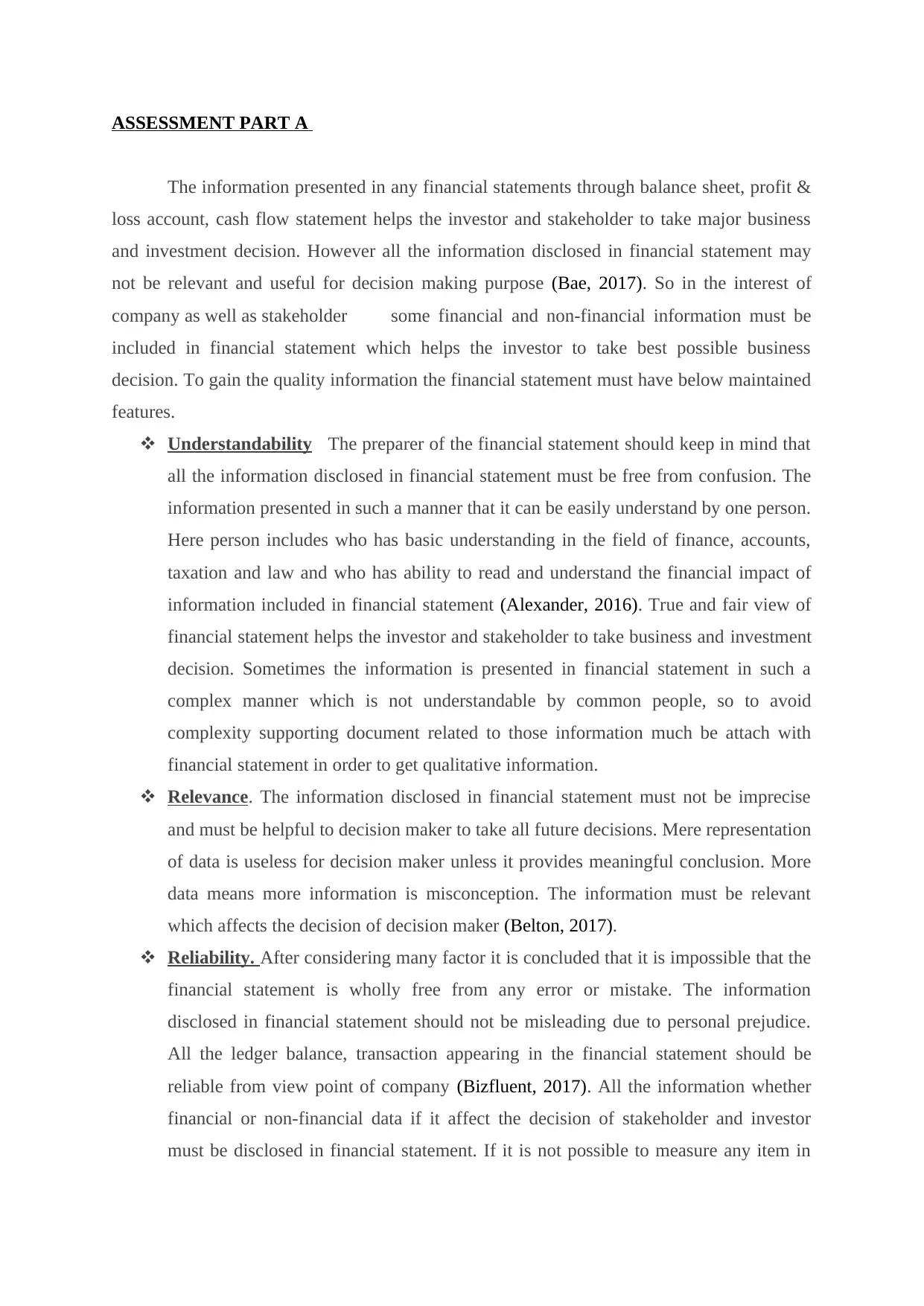
ASSESSMENT PART A
The information presented in any financial statements through balance sheet, profit &
loss account, cash flow statement helps the investor and stakeholder to take major business
and investment decision. However all the information disclosed in financial statement may
not be relevant and useful for decision making purpose (Bae, 2017). So in the interest of
company as well as stakeholder some financial and non-financial information must be
included in financial statement which helps the investor to take best possible business
decision. To gain the quality information the financial statement must have below maintained
features.
Understandability The preparer of the financial statement should keep in mind that
all the information disclosed in financial statement must be free from confusion. The
information presented in such a manner that it can be easily understand by one person.
Here person includes who has basic understanding in the field of finance, accounts,
taxation and law and who has ability to read and understand the financial impact of
information included in financial statement (Alexander, 2016). True and fair view of
financial statement helps the investor and stakeholder to take business and investment
decision. Sometimes the information is presented in financial statement in such a
complex manner which is not understandable by common people, so to avoid
complexity supporting document related to those information much be attach with
financial statement in order to get qualitative information.
Relevance. The information disclosed in financial statement must not be imprecise
and must be helpful to decision maker to take all future decisions. Mere representation
of data is useless for decision maker unless it provides meaningful conclusion. More
data means more information is misconception. The information must be relevant
which affects the decision of decision maker (Belton, 2017).
Reliability. After considering many factor it is concluded that it is impossible that the
financial statement is wholly free from any error or mistake. The information
disclosed in financial statement should not be misleading due to personal prejudice.
All the ledger balance, transaction appearing in the financial statement should be
reliable from view point of company (Bizfluent, 2017). All the information whether
financial or non-financial data if it affect the decision of stakeholder and investor
must be disclosed in financial statement. If it is not possible to measure any item in
The information presented in any financial statements through balance sheet, profit &
loss account, cash flow statement helps the investor and stakeholder to take major business
and investment decision. However all the information disclosed in financial statement may
not be relevant and useful for decision making purpose (Bae, 2017). So in the interest of
company as well as stakeholder some financial and non-financial information must be
included in financial statement which helps the investor to take best possible business
decision. To gain the quality information the financial statement must have below maintained
features.
Understandability The preparer of the financial statement should keep in mind that
all the information disclosed in financial statement must be free from confusion. The
information presented in such a manner that it can be easily understand by one person.
Here person includes who has basic understanding in the field of finance, accounts,
taxation and law and who has ability to read and understand the financial impact of
information included in financial statement (Alexander, 2016). True and fair view of
financial statement helps the investor and stakeholder to take business and investment
decision. Sometimes the information is presented in financial statement in such a
complex manner which is not understandable by common people, so to avoid
complexity supporting document related to those information much be attach with
financial statement in order to get qualitative information.
Relevance. The information disclosed in financial statement must not be imprecise
and must be helpful to decision maker to take all future decisions. Mere representation
of data is useless for decision maker unless it provides meaningful conclusion. More
data means more information is misconception. The information must be relevant
which affects the decision of decision maker (Belton, 2017).
Reliability. After considering many factor it is concluded that it is impossible that the
financial statement is wholly free from any error or mistake. The information
disclosed in financial statement should not be misleading due to personal prejudice.
All the ledger balance, transaction appearing in the financial statement should be
reliable from view point of company (Bizfluent, 2017). All the information whether
financial or non-financial data if it affect the decision of stakeholder and investor
must be disclosed in financial statement. If it is not possible to measure any item in
Paraphrase This Document
Need a fresh take? Get an instant paraphrase of this document with our AI Paraphraser
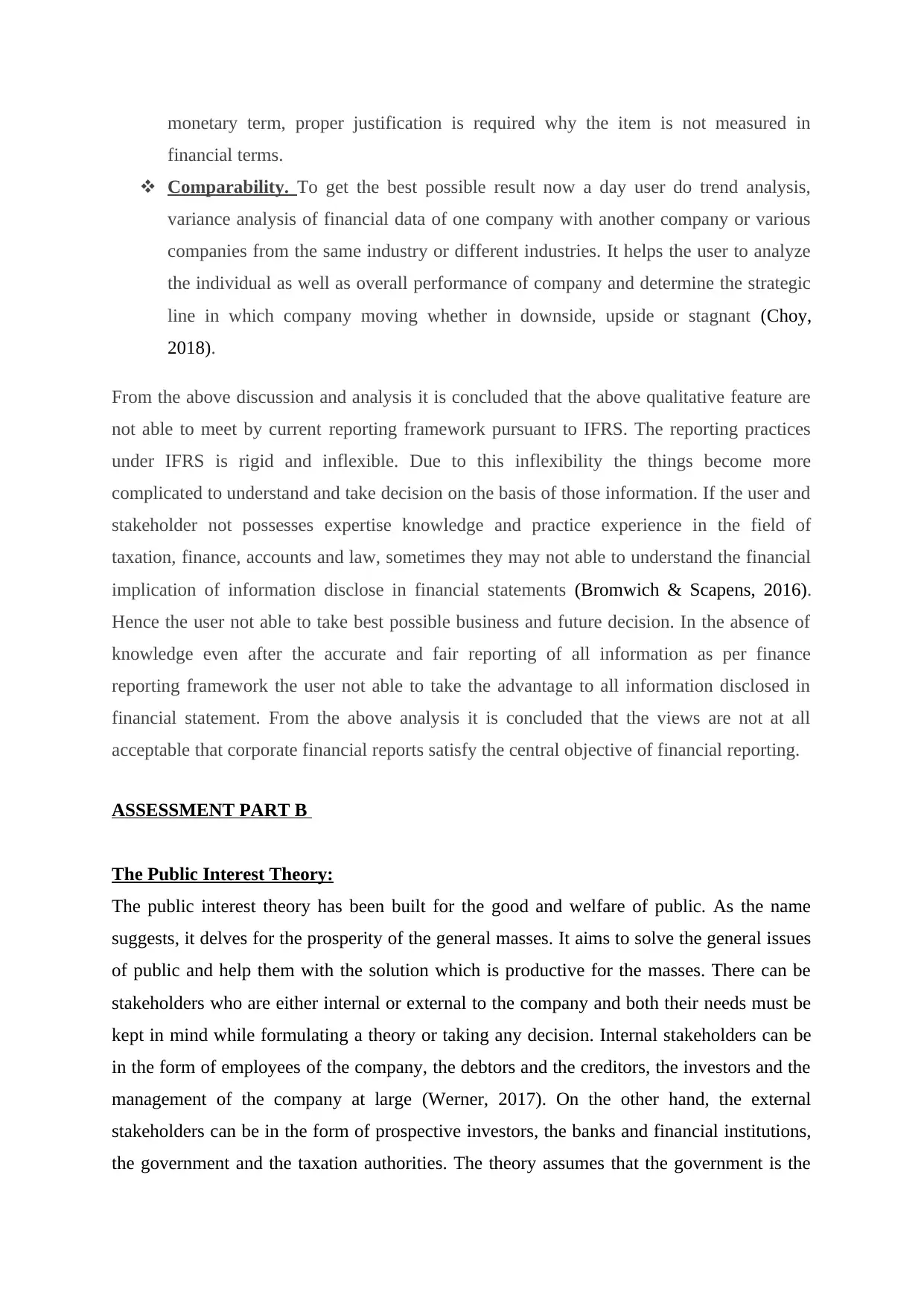
monetary term, proper justification is required why the item is not measured in
financial terms.
Comparability. To get the best possible result now a day user do trend analysis,
variance analysis of financial data of one company with another company or various
companies from the same industry or different industries. It helps the user to analyze
the individual as well as overall performance of company and determine the strategic
line in which company moving whether in downside, upside or stagnant (Choy,
2018).
From the above discussion and analysis it is concluded that the above qualitative feature are
not able to meet by current reporting framework pursuant to IFRS. The reporting practices
under IFRS is rigid and inflexible. Due to this inflexibility the things become more
complicated to understand and take decision on the basis of those information. If the user and
stakeholder not possesses expertise knowledge and practice experience in the field of
taxation, finance, accounts and law, sometimes they may not able to understand the financial
implication of information disclose in financial statements (Bromwich & Scapens, 2016).
Hence the user not able to take best possible business and future decision. In the absence of
knowledge even after the accurate and fair reporting of all information as per finance
reporting framework the user not able to take the advantage to all information disclosed in
financial statement. From the above analysis it is concluded that the views are not at all
acceptable that corporate financial reports satisfy the central objective of financial reporting.
ASSESSMENT PART B
The Public Interest Theory:
The public interest theory has been built for the good and welfare of public. As the name
suggests, it delves for the prosperity of the general masses. It aims to solve the general issues
of public and help them with the solution which is productive for the masses. There can be
stakeholders who are either internal or external to the company and both their needs must be
kept in mind while formulating a theory or taking any decision. Internal stakeholders can be
in the form of employees of the company, the debtors and the creditors, the investors and the
management of the company at large (Werner, 2017). On the other hand, the external
stakeholders can be in the form of prospective investors, the banks and financial institutions,
the government and the taxation authorities. The theory assumes that the government is the
financial terms.
Comparability. To get the best possible result now a day user do trend analysis,
variance analysis of financial data of one company with another company or various
companies from the same industry or different industries. It helps the user to analyze
the individual as well as overall performance of company and determine the strategic
line in which company moving whether in downside, upside or stagnant (Choy,
2018).
From the above discussion and analysis it is concluded that the above qualitative feature are
not able to meet by current reporting framework pursuant to IFRS. The reporting practices
under IFRS is rigid and inflexible. Due to this inflexibility the things become more
complicated to understand and take decision on the basis of those information. If the user and
stakeholder not possesses expertise knowledge and practice experience in the field of
taxation, finance, accounts and law, sometimes they may not able to understand the financial
implication of information disclose in financial statements (Bromwich & Scapens, 2016).
Hence the user not able to take best possible business and future decision. In the absence of
knowledge even after the accurate and fair reporting of all information as per finance
reporting framework the user not able to take the advantage to all information disclosed in
financial statement. From the above analysis it is concluded that the views are not at all
acceptable that corporate financial reports satisfy the central objective of financial reporting.
ASSESSMENT PART B
The Public Interest Theory:
The public interest theory has been built for the good and welfare of public. As the name
suggests, it delves for the prosperity of the general masses. It aims to solve the general issues
of public and help them with the solution which is productive for the masses. There can be
stakeholders who are either internal or external to the company and both their needs must be
kept in mind while formulating a theory or taking any decision. Internal stakeholders can be
in the form of employees of the company, the debtors and the creditors, the investors and the
management of the company at large (Werner, 2017). On the other hand, the external
stakeholders can be in the form of prospective investors, the banks and financial institutions,
the government and the taxation authorities. The theory assumes that the government is the
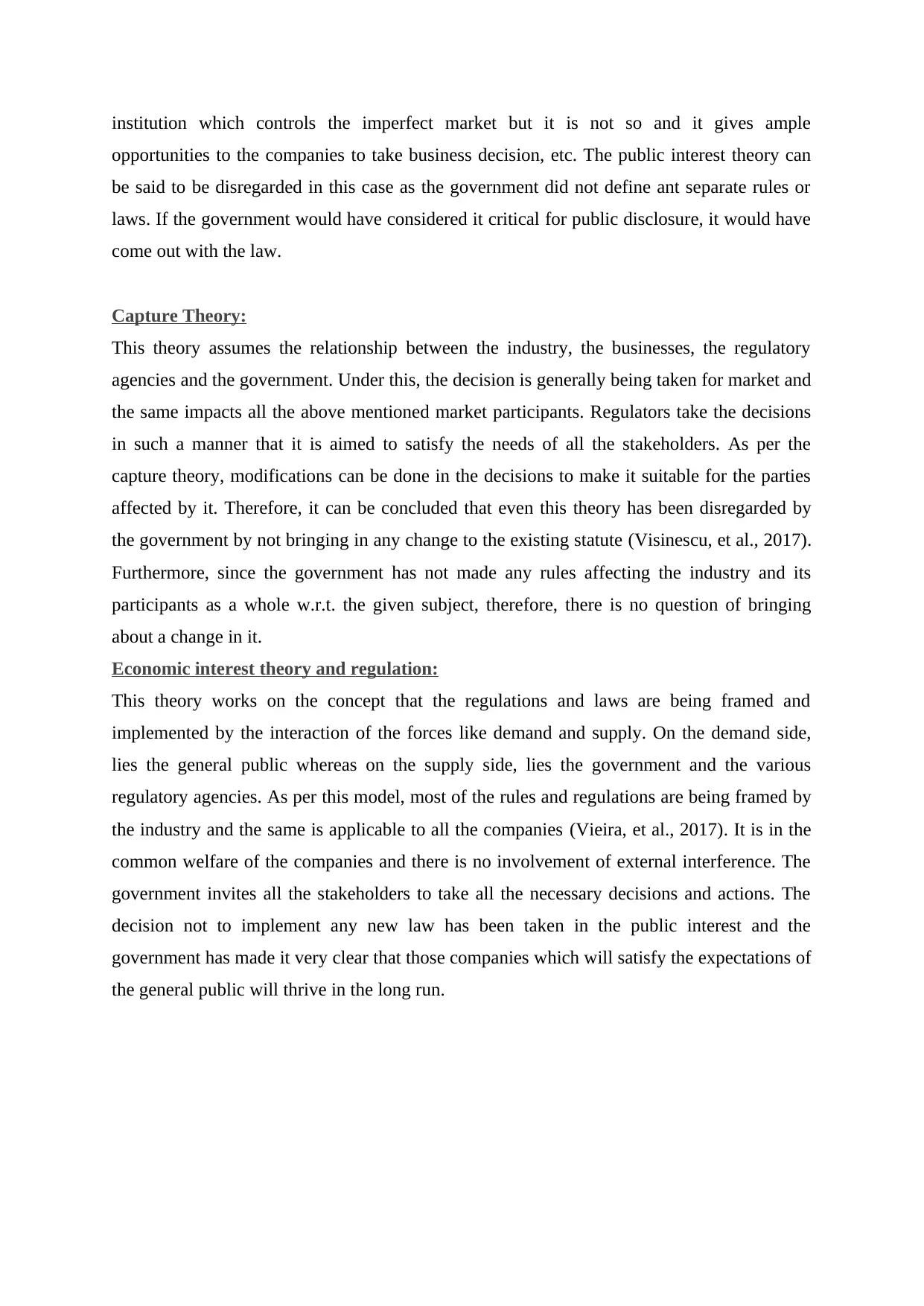
institution which controls the imperfect market but it is not so and it gives ample
opportunities to the companies to take business decision, etc. The public interest theory can
be said to be disregarded in this case as the government did not define ant separate rules or
laws. If the government would have considered it critical for public disclosure, it would have
come out with the law.
Capture Theory:
This theory assumes the relationship between the industry, the businesses, the regulatory
agencies and the government. Under this, the decision is generally being taken for market and
the same impacts all the above mentioned market participants. Regulators take the decisions
in such a manner that it is aimed to satisfy the needs of all the stakeholders. As per the
capture theory, modifications can be done in the decisions to make it suitable for the parties
affected by it. Therefore, it can be concluded that even this theory has been disregarded by
the government by not bringing in any change to the existing statute (Visinescu, et al., 2017).
Furthermore, since the government has not made any rules affecting the industry and its
participants as a whole w.r.t. the given subject, therefore, there is no question of bringing
about a change in it.
Economic interest theory and regulation:
This theory works on the concept that the regulations and laws are being framed and
implemented by the interaction of the forces like demand and supply. On the demand side,
lies the general public whereas on the supply side, lies the government and the various
regulatory agencies. As per this model, most of the rules and regulations are being framed by
the industry and the same is applicable to all the companies (Vieira, et al., 2017). It is in the
common welfare of the companies and there is no involvement of external interference. The
government invites all the stakeholders to take all the necessary decisions and actions. The
decision not to implement any new law has been taken in the public interest and the
government has made it very clear that those companies which will satisfy the expectations of
the general public will thrive in the long run.
opportunities to the companies to take business decision, etc. The public interest theory can
be said to be disregarded in this case as the government did not define ant separate rules or
laws. If the government would have considered it critical for public disclosure, it would have
come out with the law.
Capture Theory:
This theory assumes the relationship between the industry, the businesses, the regulatory
agencies and the government. Under this, the decision is generally being taken for market and
the same impacts all the above mentioned market participants. Regulators take the decisions
in such a manner that it is aimed to satisfy the needs of all the stakeholders. As per the
capture theory, modifications can be done in the decisions to make it suitable for the parties
affected by it. Therefore, it can be concluded that even this theory has been disregarded by
the government by not bringing in any change to the existing statute (Visinescu, et al., 2017).
Furthermore, since the government has not made any rules affecting the industry and its
participants as a whole w.r.t. the given subject, therefore, there is no question of bringing
about a change in it.
Economic interest theory and regulation:
This theory works on the concept that the regulations and laws are being framed and
implemented by the interaction of the forces like demand and supply. On the demand side,
lies the general public whereas on the supply side, lies the government and the various
regulatory agencies. As per this model, most of the rules and regulations are being framed by
the industry and the same is applicable to all the companies (Vieira, et al., 2017). It is in the
common welfare of the companies and there is no involvement of external interference. The
government invites all the stakeholders to take all the necessary decisions and actions. The
decision not to implement any new law has been taken in the public interest and the
government has made it very clear that those companies which will satisfy the expectations of
the general public will thrive in the long run.
⊘ This is a preview!⊘
Do you want full access?
Subscribe today to unlock all pages.

Trusted by 1+ million students worldwide
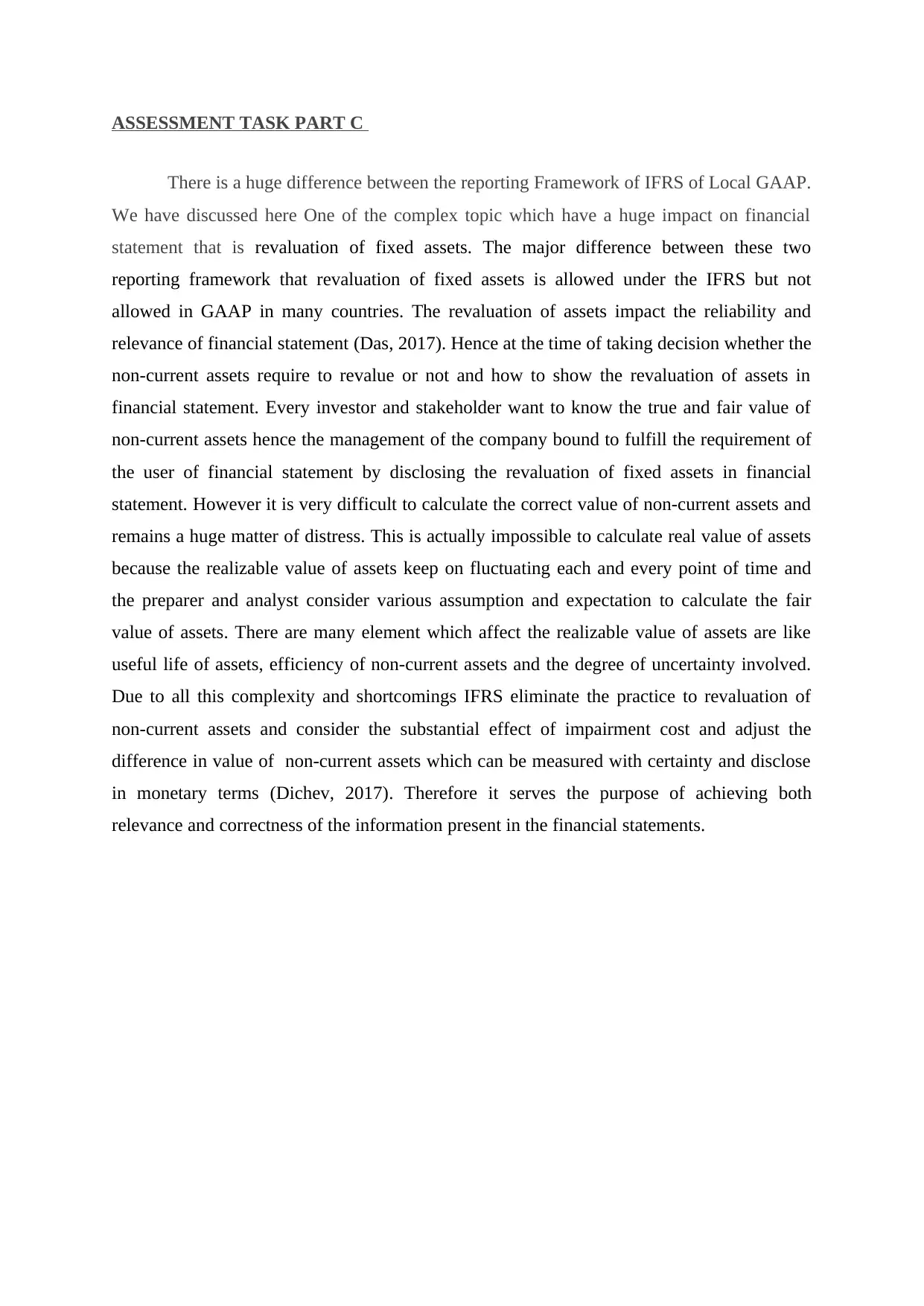
ASSESSMENT TASK PART C
There is a huge difference between the reporting Framework of IFRS of Local GAAP.
We have discussed here One of the complex topic which have a huge impact on financial
statement that is revaluation of fixed assets. The major difference between these two
reporting framework that revaluation of fixed assets is allowed under the IFRS but not
allowed in GAAP in many countries. The revaluation of assets impact the reliability and
relevance of financial statement (Das, 2017). Hence at the time of taking decision whether the
non-current assets require to revalue or not and how to show the revaluation of assets in
financial statement. Every investor and stakeholder want to know the true and fair value of
non-current assets hence the management of the company bound to fulfill the requirement of
the user of financial statement by disclosing the revaluation of fixed assets in financial
statement. However it is very difficult to calculate the correct value of non-current assets and
remains a huge matter of distress. This is actually impossible to calculate real value of assets
because the realizable value of assets keep on fluctuating each and every point of time and
the preparer and analyst consider various assumption and expectation to calculate the fair
value of assets. There are many element which affect the realizable value of assets are like
useful life of assets, efficiency of non-current assets and the degree of uncertainty involved.
Due to all this complexity and shortcomings IFRS eliminate the practice to revaluation of
non-current assets and consider the substantial effect of impairment cost and adjust the
difference in value of non-current assets which can be measured with certainty and disclose
in monetary terms (Dichev, 2017). Therefore it serves the purpose of achieving both
relevance and correctness of the information present in the financial statements.
There is a huge difference between the reporting Framework of IFRS of Local GAAP.
We have discussed here One of the complex topic which have a huge impact on financial
statement that is revaluation of fixed assets. The major difference between these two
reporting framework that revaluation of fixed assets is allowed under the IFRS but not
allowed in GAAP in many countries. The revaluation of assets impact the reliability and
relevance of financial statement (Das, 2017). Hence at the time of taking decision whether the
non-current assets require to revalue or not and how to show the revaluation of assets in
financial statement. Every investor and stakeholder want to know the true and fair value of
non-current assets hence the management of the company bound to fulfill the requirement of
the user of financial statement by disclosing the revaluation of fixed assets in financial
statement. However it is very difficult to calculate the correct value of non-current assets and
remains a huge matter of distress. This is actually impossible to calculate real value of assets
because the realizable value of assets keep on fluctuating each and every point of time and
the preparer and analyst consider various assumption and expectation to calculate the fair
value of assets. There are many element which affect the realizable value of assets are like
useful life of assets, efficiency of non-current assets and the degree of uncertainty involved.
Due to all this complexity and shortcomings IFRS eliminate the practice to revaluation of
non-current assets and consider the substantial effect of impairment cost and adjust the
difference in value of non-current assets which can be measured with certainty and disclose
in monetary terms (Dichev, 2017). Therefore it serves the purpose of achieving both
relevance and correctness of the information present in the financial statements.
Paraphrase This Document
Need a fresh take? Get an instant paraphrase of this document with our AI Paraphraser
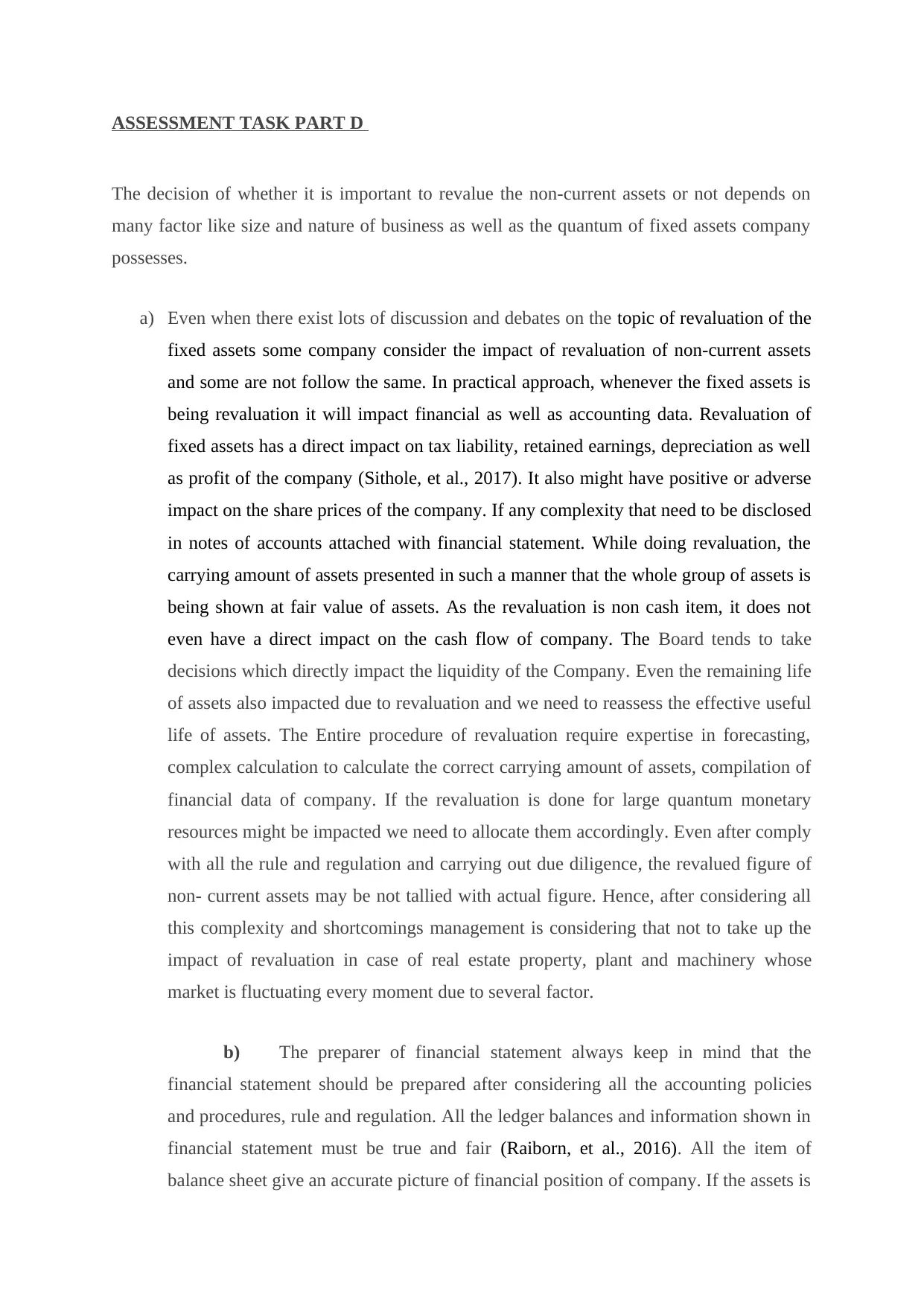
ASSESSMENT TASK PART D
The decision of whether it is important to revalue the non-current assets or not depends on
many factor like size and nature of business as well as the quantum of fixed assets company
possesses.
a) Even when there exist lots of discussion and debates on the topic of revaluation of the
fixed assets some company consider the impact of revaluation of non-current assets
and some are not follow the same. In practical approach, whenever the fixed assets is
being revaluation it will impact financial as well as accounting data. Revaluation of
fixed assets has a direct impact on tax liability, retained earnings, depreciation as well
as profit of the company (Sithole, et al., 2017). It also might have positive or adverse
impact on the share prices of the company. If any complexity that need to be disclosed
in notes of accounts attached with financial statement. While doing revaluation, the
carrying amount of assets presented in such a manner that the whole group of assets is
being shown at fair value of assets. As the revaluation is non cash item, it does not
even have a direct impact on the cash flow of company. The Board tends to take
decisions which directly impact the liquidity of the Company. Even the remaining life
of assets also impacted due to revaluation and we need to reassess the effective useful
life of assets. The Entire procedure of revaluation require expertise in forecasting,
complex calculation to calculate the correct carrying amount of assets, compilation of
financial data of company. If the revaluation is done for large quantum monetary
resources might be impacted we need to allocate them accordingly. Even after comply
with all the rule and regulation and carrying out due diligence, the revalued figure of
non- current assets may be not tallied with actual figure. Hence, after considering all
this complexity and shortcomings management is considering that not to take up the
impact of revaluation in case of real estate property, plant and machinery whose
market is fluctuating every moment due to several factor.
b) The preparer of financial statement always keep in mind that the
financial statement should be prepared after considering all the accounting policies
and procedures, rule and regulation. All the ledger balances and information shown in
financial statement must be true and fair (Raiborn, et al., 2016). All the item of
balance sheet give an accurate picture of financial position of company. If the assets is
The decision of whether it is important to revalue the non-current assets or not depends on
many factor like size and nature of business as well as the quantum of fixed assets company
possesses.
a) Even when there exist lots of discussion and debates on the topic of revaluation of the
fixed assets some company consider the impact of revaluation of non-current assets
and some are not follow the same. In practical approach, whenever the fixed assets is
being revaluation it will impact financial as well as accounting data. Revaluation of
fixed assets has a direct impact on tax liability, retained earnings, depreciation as well
as profit of the company (Sithole, et al., 2017). It also might have positive or adverse
impact on the share prices of the company. If any complexity that need to be disclosed
in notes of accounts attached with financial statement. While doing revaluation, the
carrying amount of assets presented in such a manner that the whole group of assets is
being shown at fair value of assets. As the revaluation is non cash item, it does not
even have a direct impact on the cash flow of company. The Board tends to take
decisions which directly impact the liquidity of the Company. Even the remaining life
of assets also impacted due to revaluation and we need to reassess the effective useful
life of assets. The Entire procedure of revaluation require expertise in forecasting,
complex calculation to calculate the correct carrying amount of assets, compilation of
financial data of company. If the revaluation is done for large quantum monetary
resources might be impacted we need to allocate them accordingly. Even after comply
with all the rule and regulation and carrying out due diligence, the revalued figure of
non- current assets may be not tallied with actual figure. Hence, after considering all
this complexity and shortcomings management is considering that not to take up the
impact of revaluation in case of real estate property, plant and machinery whose
market is fluctuating every moment due to several factor.
b) The preparer of financial statement always keep in mind that the
financial statement should be prepared after considering all the accounting policies
and procedures, rule and regulation. All the ledger balances and information shown in
financial statement must be true and fair (Raiborn, et al., 2016). All the item of
balance sheet give an accurate picture of financial position of company. If the assets is
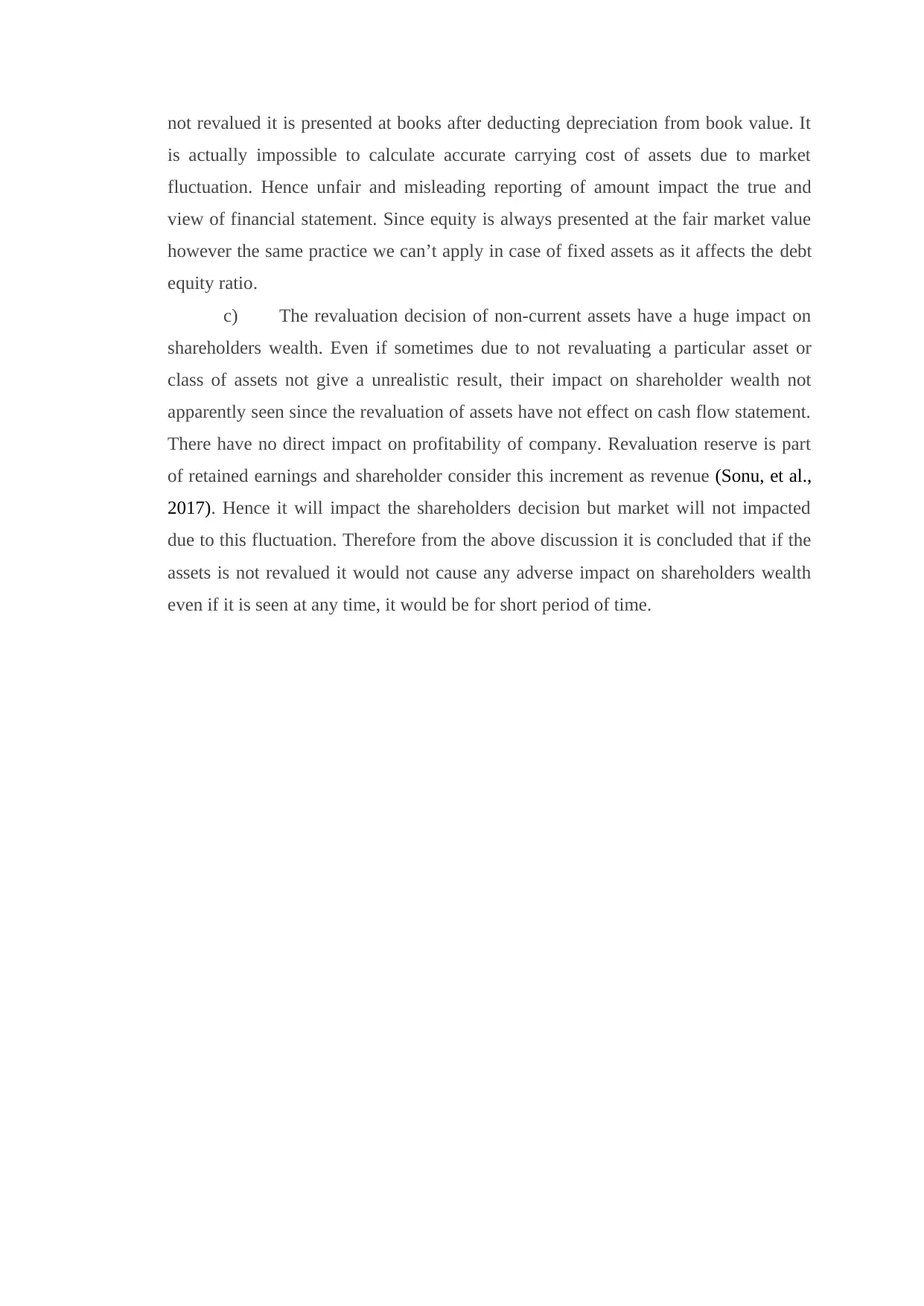
not revalued it is presented at books after deducting depreciation from book value. It
is actually impossible to calculate accurate carrying cost of assets due to market
fluctuation. Hence unfair and misleading reporting of amount impact the true and
view of financial statement. Since equity is always presented at the fair market value
however the same practice we can’t apply in case of fixed assets as it affects the debt
equity ratio.
c) The revaluation decision of non-current assets have a huge impact on
shareholders wealth. Even if sometimes due to not revaluating a particular asset or
class of assets not give a unrealistic result, their impact on shareholder wealth not
apparently seen since the revaluation of assets have not effect on cash flow statement.
There have no direct impact on profitability of company. Revaluation reserve is part
of retained earnings and shareholder consider this increment as revenue (Sonu, et al.,
2017). Hence it will impact the shareholders decision but market will not impacted
due to this fluctuation. Therefore from the above discussion it is concluded that if the
assets is not revalued it would not cause any adverse impact on shareholders wealth
even if it is seen at any time, it would be for short period of time.
is actually impossible to calculate accurate carrying cost of assets due to market
fluctuation. Hence unfair and misleading reporting of amount impact the true and
view of financial statement. Since equity is always presented at the fair market value
however the same practice we can’t apply in case of fixed assets as it affects the debt
equity ratio.
c) The revaluation decision of non-current assets have a huge impact on
shareholders wealth. Even if sometimes due to not revaluating a particular asset or
class of assets not give a unrealistic result, their impact on shareholder wealth not
apparently seen since the revaluation of assets have not effect on cash flow statement.
There have no direct impact on profitability of company. Revaluation reserve is part
of retained earnings and shareholder consider this increment as revenue (Sonu, et al.,
2017). Hence it will impact the shareholders decision but market will not impacted
due to this fluctuation. Therefore from the above discussion it is concluded that if the
assets is not revalued it would not cause any adverse impact on shareholders wealth
even if it is seen at any time, it would be for short period of time.
⊘ This is a preview!⊘
Do you want full access?
Subscribe today to unlock all pages.

Trusted by 1+ million students worldwide
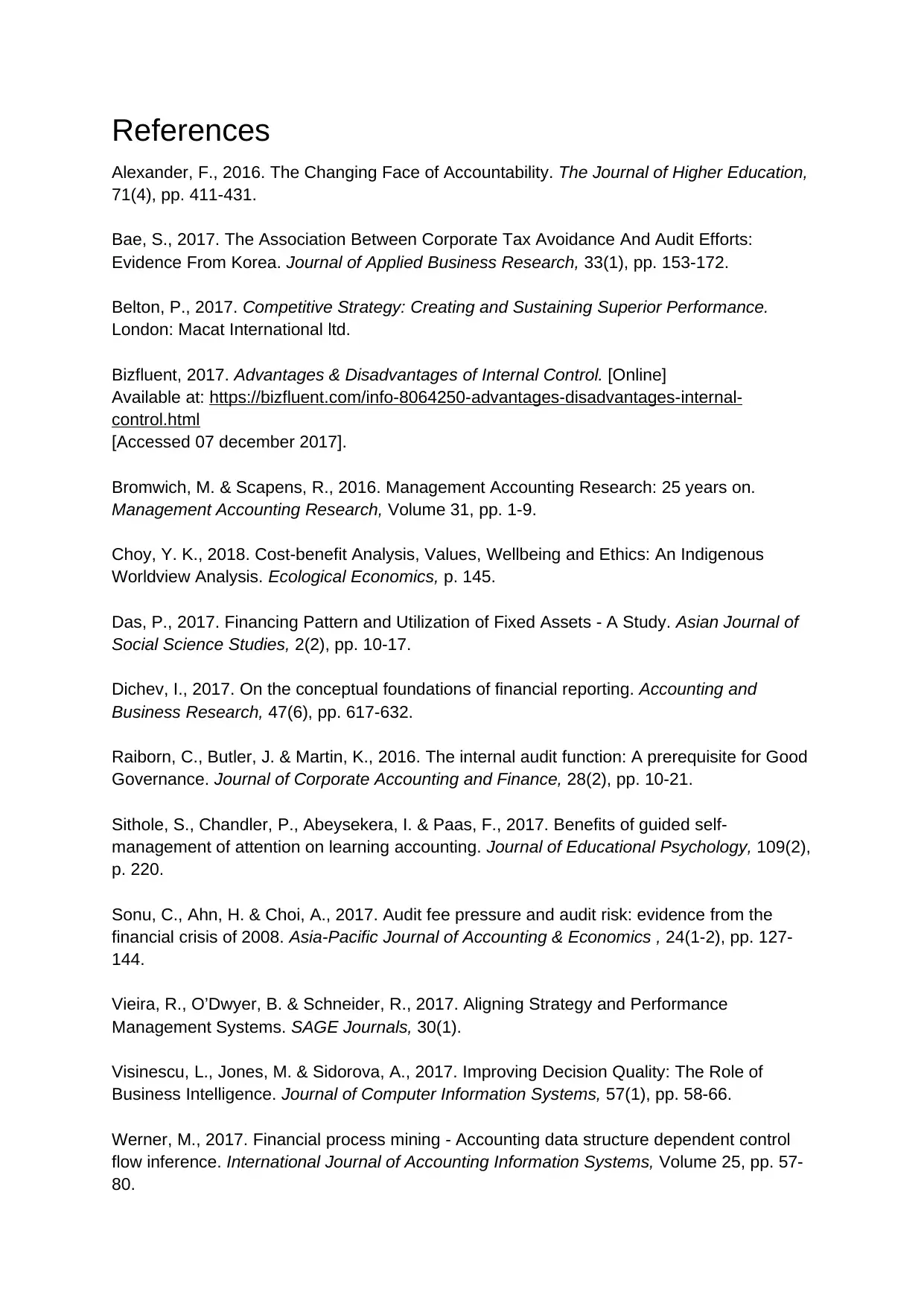
References
Alexander, F., 2016. The Changing Face of Accountability. The Journal of Higher Education,
71(4), pp. 411-431.
Bae, S., 2017. The Association Between Corporate Tax Avoidance And Audit Efforts:
Evidence From Korea. Journal of Applied Business Research, 33(1), pp. 153-172.
Belton, P., 2017. Competitive Strategy: Creating and Sustaining Superior Performance.
London: Macat International ltd.
Bizfluent, 2017. Advantages & Disadvantages of Internal Control. [Online]
Available at: https://bizfluent.com/info-8064250-advantages-disadvantages-internal-
control.html
[Accessed 07 december 2017].
Bromwich, M. & Scapens, R., 2016. Management Accounting Research: 25 years on.
Management Accounting Research, Volume 31, pp. 1-9.
Choy, Y. K., 2018. Cost-benefit Analysis, Values, Wellbeing and Ethics: An Indigenous
Worldview Analysis. Ecological Economics, p. 145.
Das, P., 2017. Financing Pattern and Utilization of Fixed Assets - A Study. Asian Journal of
Social Science Studies, 2(2), pp. 10-17.
Dichev, I., 2017. On the conceptual foundations of financial reporting. Accounting and
Business Research, 47(6), pp. 617-632.
Raiborn, C., Butler, J. & Martin, K., 2016. The internal audit function: A prerequisite for Good
Governance. Journal of Corporate Accounting and Finance, 28(2), pp. 10-21.
Sithole, S., Chandler, P., Abeysekera, I. & Paas, F., 2017. Benefits of guided self-
management of attention on learning accounting. Journal of Educational Psychology, 109(2),
p. 220.
Sonu, C., Ahn, H. & Choi, A., 2017. Audit fee pressure and audit risk: evidence from the
financial crisis of 2008. Asia-Pacific Journal of Accounting & Economics , 24(1-2), pp. 127-
144.
Vieira, R., O’Dwyer, B. & Schneider, R., 2017. Aligning Strategy and Performance
Management Systems. SAGE Journals, 30(1).
Visinescu, L., Jones, M. & Sidorova, A., 2017. Improving Decision Quality: The Role of
Business Intelligence. Journal of Computer Information Systems, 57(1), pp. 58-66.
Werner, M., 2017. Financial process mining - Accounting data structure dependent control
flow inference. International Journal of Accounting Information Systems, Volume 25, pp. 57-
80.
Alexander, F., 2016. The Changing Face of Accountability. The Journal of Higher Education,
71(4), pp. 411-431.
Bae, S., 2017. The Association Between Corporate Tax Avoidance And Audit Efforts:
Evidence From Korea. Journal of Applied Business Research, 33(1), pp. 153-172.
Belton, P., 2017. Competitive Strategy: Creating and Sustaining Superior Performance.
London: Macat International ltd.
Bizfluent, 2017. Advantages & Disadvantages of Internal Control. [Online]
Available at: https://bizfluent.com/info-8064250-advantages-disadvantages-internal-
control.html
[Accessed 07 december 2017].
Bromwich, M. & Scapens, R., 2016. Management Accounting Research: 25 years on.
Management Accounting Research, Volume 31, pp. 1-9.
Choy, Y. K., 2018. Cost-benefit Analysis, Values, Wellbeing and Ethics: An Indigenous
Worldview Analysis. Ecological Economics, p. 145.
Das, P., 2017. Financing Pattern and Utilization of Fixed Assets - A Study. Asian Journal of
Social Science Studies, 2(2), pp. 10-17.
Dichev, I., 2017. On the conceptual foundations of financial reporting. Accounting and
Business Research, 47(6), pp. 617-632.
Raiborn, C., Butler, J. & Martin, K., 2016. The internal audit function: A prerequisite for Good
Governance. Journal of Corporate Accounting and Finance, 28(2), pp. 10-21.
Sithole, S., Chandler, P., Abeysekera, I. & Paas, F., 2017. Benefits of guided self-
management of attention on learning accounting. Journal of Educational Psychology, 109(2),
p. 220.
Sonu, C., Ahn, H. & Choi, A., 2017. Audit fee pressure and audit risk: evidence from the
financial crisis of 2008. Asia-Pacific Journal of Accounting & Economics , 24(1-2), pp. 127-
144.
Vieira, R., O’Dwyer, B. & Schneider, R., 2017. Aligning Strategy and Performance
Management Systems. SAGE Journals, 30(1).
Visinescu, L., Jones, M. & Sidorova, A., 2017. Improving Decision Quality: The Role of
Business Intelligence. Journal of Computer Information Systems, 57(1), pp. 58-66.
Werner, M., 2017. Financial process mining - Accounting data structure dependent control
flow inference. International Journal of Accounting Information Systems, Volume 25, pp. 57-
80.
Paraphrase This Document
Need a fresh take? Get an instant paraphrase of this document with our AI Paraphraser

1 out of 8
Related Documents
Your All-in-One AI-Powered Toolkit for Academic Success.
+13062052269
info@desklib.com
Available 24*7 on WhatsApp / Email
![[object Object]](/_next/static/media/star-bottom.7253800d.svg)
Unlock your academic potential
Copyright © 2020–2025 A2Z Services. All Rights Reserved. Developed and managed by ZUCOL.





